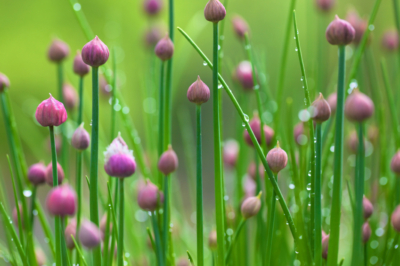Many people believe that the chive flowers are poisonous and therefore cut off the flower-bearing stalks in time. In fact, the hard and very bitter flower stalks are inedible, but their flowers and buds are all the tastier. Try it!

Flowering time and harvest
Chives have a very long flowering period: depending on the seasonal weather, the aromatic herb blooms from March until October. The flower looks very pretty and from a distance resembles a fluffy ball. For this reason, in addition to the common chives, there are numerous ornamental chives that are cultivated solely for their striking flower. Chives usually bloom in a delicate shade of purple, but there are also white and pink flowering varieties. Cut the just-so-fully-flowered blossoms from the stalk with a sharp knife; you can leave this on the plant. The best time for harvesting is early morning, as the content of essential oils is highest then – and besides, early in the morning there are not yet so many nectar-collecting insects around.
Recipe ideas for chive blossoms
Use only healthy, undamaged and clean chive blossoms. They should not be washed under any circumstances, but at most cleaned by hand. In addition, it is important to inspect the flowers for any insects and examine them if necessary – beetles, bees and co. like to hide in the tubes of the stamens. You can use the chive blossoms just like the stalks, for example on buttered bread or sprinkled over a salad. Furthermore, they can also be pickled in salt, vinegar or oil, frozen or even used for cooking.
Green sauce with chive flowers
Frankfurter Grüne Sauce is a well-known cold herb sauce, usually eaten with jacket or boiled potatoes. A refreshing, light and healthy food for hot summer days! We have modified the original recipe a little bit:
- Fill 300 grams of mixed and chopped herbs (curly parsley, chive flowers, cress and chervil, borage and sorrel, and lemon balm) in a tall container.
- Combine sour cream, sour cream, and milk so that a total of 500 grams is combined.
- Stir the mixture until smooth and add it to the herbs.
- Blend until the mixture turns a nice green color.
- Add a tablespoon each of vinegar and oil and salt and pepper to taste.
- Now stir in two hard boiled and chopped eggs.
- Let the sauce sit in the refrigerator for at least two hours.
- Enjoy your meal!
By the way, after harvesting the flowers, you should radically cut down the stalks so that there is only a maximum of two to three centimeters above the ground. This also works great with a lawn mower. The chives will quickly sprout again.
Tips & tricks
The same as for the chive blossom applies to a whole range of herb, fruit and vegetable blossoms. These can be used to create numerous delicious ideas: The blossoms can be stuffed (e.g., squash and zucchini blossoms), pickled in vinegar, salt or sugar (e.g., blossom vinegar made from elderberry or apple blossoms, thyme salt or lavender sugar) or made into a sweet liqueur (e.g., elderberry blossom liqueur), syrup (for making lemonade), jelly and much more.

